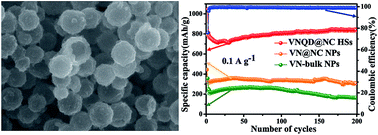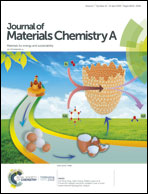In situ formation of vanadium nitride quantum dots on N-doped carbon hollow spheres for superior lithium and sodium storage†
Abstract
Transition-metal nitrides have captured extensive attention for battery applications ascribed to their high electrical conductivity and considerable capacity, whilst sluggish kinetics constrains their rate capability and thus limited their practical applications in lithium or sodium ion batteries (LIBs or SIBs). Herein, we report an effective approach to prepare nanohybrids of vanadium nitride quantum dots that were uniformly embedded within porous shells of N-doped carbon hollow spheres (VNQD@NC HSs). These manifest attractive advantages as anodes of LIBs and SIBs with facilitated transfer for both electron and Li+/Na+ and robust structural integrity, primarily benefiting from structural features of interior voids, N-doped carbon matrix, and quantum dot level of VN active material. Accordingly, the VNQD@NC HSs electrode can deliver a reversible capacity of up to 832 mA h g−1 at a current density of 0.1 A g−1 after 200 cycles, along with a high rate performance of 378 mA h g−1 at 6.4 A g−1 for LIBs. And for SIBs, the VNQD@NC HSs also retains a capacity of 361 mA h g−1 at a current density of 0.1 A g−1 after 200 cycles and a reversible capacity of 306 mA h g−1 over 1400 cycles at 1 A g−1.



 Please wait while we load your content...
Please wait while we load your content...